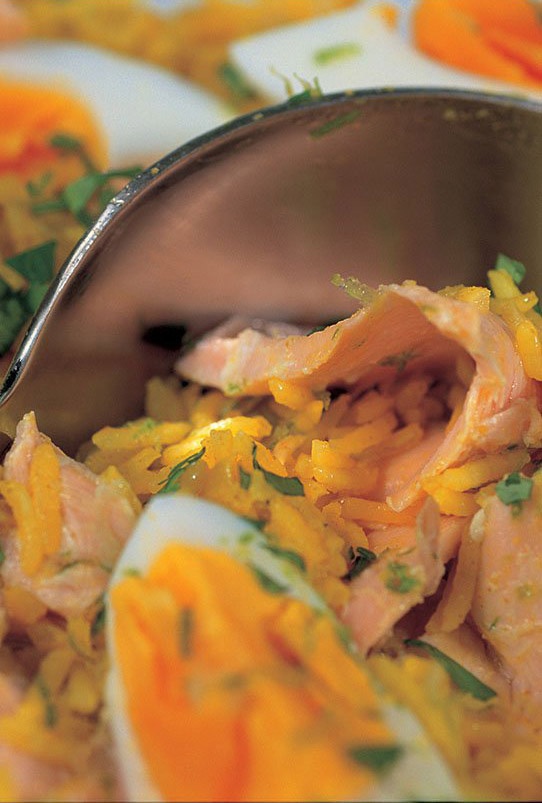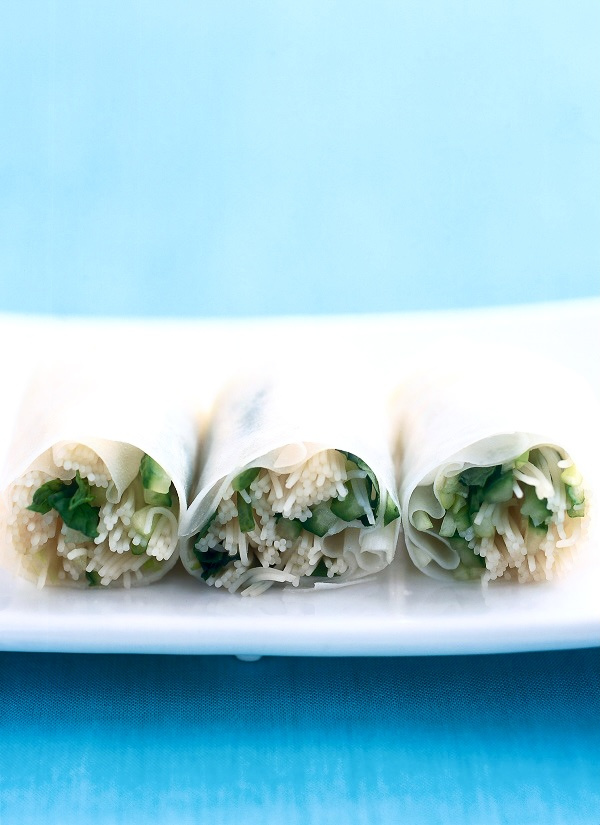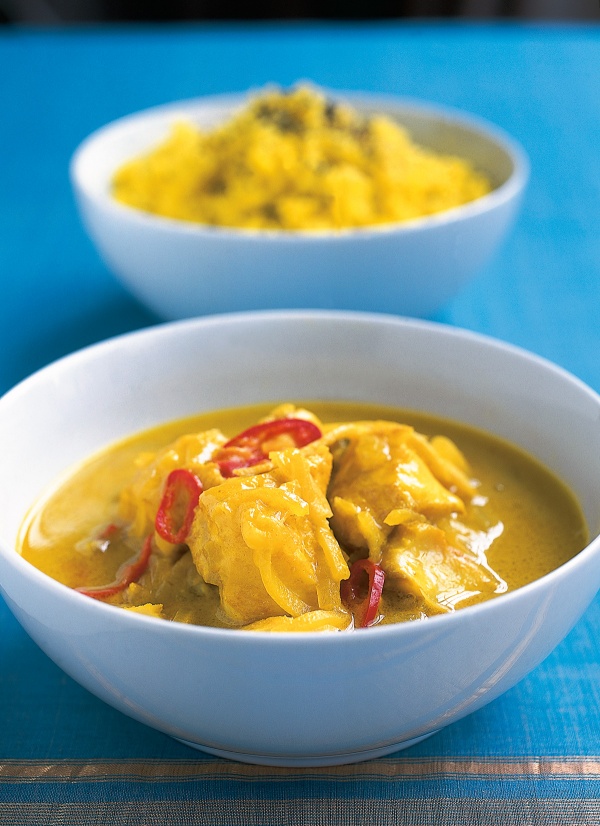Salmon Kedgeree with Lime and Coriander
by Nigella. Featured in NIGELLA BITESIntroduction
Kedgeree started life, in India, as a dish of lentils and rice and then, translated into the kitchens of the Raj, and brought back home, became an eggy, golden pile of rice punctuated with slabby chunks of smoked haddock. When I was a child it remained as a comforting brunch dish, still part of the homely repertoire of the normal British cook. Here, I've fiddled with it some more, replacing the earthier Indian flavours with the sharper ones of Thailand and South East Asia and trading the strident tones of the smoked haddock for gentle, fleshy salmon, beautifully coral against the turmeric-stained gold of the rice.
Kedgeree started life, in India, as a dish of lentils and rice and then, translated into the kitchens of the Raj, and brought back home, became an eggy, golden pile of rice punctuated with slabby chunks of smoked haddock. When I was a child it remained as a comforting brunch dish, still part of the homely repertoire of the normal British cook. Here, I've fiddled with it some more, replacing the earthier Indian flavours with the sharper ones of Thailand and South East Asia and trading the strident tones of the smoked haddock for gentle, fleshy salmon, beautifully coral against the turmeric-stained gold of the rice.

Share or save this
Ingredients
Serves: 6
- 4 salmon fillets (approx. 3cm / 1 inch thick - skinned (about 750g / 1¾lb in total), and preferably Alaskan, organic or ASC-certified Scottish salmon)
- 2 makrut lime leaves (torn into pieces)
- 45 grams unsalted butter
- 1 teaspoon olive oil
- 1 onion (finely chopped)
- ½ teaspoon ground coriander
- ½ teaspoon ground cumin
- ½ teaspoon turmeric
- 225 grams basmati rice
- 3 hard-boiled eggs (quartered)
- 3 tablespoons chopped fresh coriander (plus more for sprinkling)
- zest and juice of 1 lime (plus segments to serve)
- thai fish sauce (nam pla) (to taste)
- 4 salmon fillets (approx. 3cm / 1 inch thick - skinned (about 750g / 1¾lb in total), and preferably Alaskan, organic or ASC-certified Scottish salmon)
- 2 makrut lime leaves (torn into pieces)
- 3 tablespoons unsalted butter
- 1 teaspoon olive oil
- 1 onion (finely chopped)
- ½ teaspoon ground coriander
- ½ teaspoon ground cumin
- ½ teaspoon turmeric
- 1¼ cups basmati rice
- 3 hard-boiled eggs (quartered)
- 3 tablespoons chopped cilantro (plus more for sprinkling)
- zest and juice of 1 lime (plus segments to serve)
- thai fish sauce (nam pla) (to taste)
Method
- Preheat the oven to 220°C/200°C Fan/gas mark 7/425ºF. This is because the easiest way to poach the salmon for this is to do it in the oven. So: pour 500ml / 2 cups of cold water into a roasting dish, add the lime leaves and then the salmon. Cover the dish with foil, put in the oven and cook for about 15 minutes, by which time the salmon should be tender. Remove the dish from the oven and drain the liquid off into a jug. Keep the fish warm simply by replacing the foil on the dish.
- Melt the butter in a wide, heavy saucepan that has a tight-fitting lid, and add the oil to stop the butter burning. Soften the onion in the pan and add the spices, then keep cooking till the onion is slightly translucent and suffused with the soft perfume of the spices. Add the rice and stir with a wooden spoon so that it's all well coated. There's not enough onion to give a heavy coating: just make sure the rice is fragrantly slicked.
- Pour in the reserved liquid from the jug about 500ml / 2 cups — and stir before covering with the lid and cooking gently for about 15 minutes. If your stove is vociferous you may need a heat-diffuser.
- At the end of the cooking time, when the rice is tender and has lost all chalkiness, turn off the heat, remove the lid, cover the pan with a tea towel and then replace the lid. This will help absorb any extra moisture from the rice. It is also the best way to let the rice stand without getting claggy or cold, which is useful when you've got a few friends and a few dishes to keep your eye on. Just before you want to eat, drain off any extra liquid that's collected in the dish with the salmon, then flake the fish with a fork. Add to it the rice, eggs, coriander, lime juice and a drop or two of fish sauce. Stir gently to mix — I use a couple of wooden paddles or spatulas — and taste to see if you want any more lime juice or fish sauce. Sprinkle over the zest from the two juiced halves of the lime and serve. I love it served just as it is in the roasting dish, but if you want to, and I often do (consistency is a requirement of a recipe but not a cook), decant into a large plate before you add the lime zest, then surround with lime segments and add the zest and a small handful of freshly chopped coriander.
- This is one of those rare dishes that manages to be comforting and light at the same time. And — should you have leftovers, which I wouldn't bank on — it's heavenly eaten, as all leftovers demand to be, standing up, straight from the fridge.
- Preheat the oven to 220°C/200°C Fan/gas mark 7/425ºF. This is because the easiest way to poach the salmon for this is to do it in the oven. So: pour 500ml / 2 cups of cold water into a roasting dish, add the lime leaves and then the salmon. Cover the dish with foil, put in the oven and cook for about 15 minutes, by which time the salmon should be tender. Remove the dish from the oven and drain the liquid off into a jug. Keep the fish warm simply by replacing the foil on the dish.
- Melt the butter in a wide, heavy saucepan that has a tight-fitting lid, and add the oil to stop the butter burning. Soften the onion in the pan and add the spices, then keep cooking till the onion is slightly translucent and suffused with the soft perfume of the spices. Add the rice and stir with a wooden spoon so that it's all well coated. There's not enough onion to give a heavy coating: just make sure the rice is fragrantly slicked.
- Pour in the reserved liquid from the jug about 500ml / 2 cups — and stir before covering with the lid and cooking gently for about 15 minutes. If your stove is vociferous you may need a heat-diffuser.
- At the end of the cooking time, when the rice is tender and has lost all chalkiness, turn off the heat, remove the lid, cover the pan with a tea towel and then replace the lid. This will help absorb any extra moisture from the rice. It is also the best way to let the rice stand without getting claggy or cold, which is useful when you've got a few friends and a few dishes to keep your eye on. Just before you want to eat, drain off any extra liquid that's collected in the dish with the salmon, then flake the fish with a fork. Add to it the rice, eggs, coriander, lime juice and a drop or two of fish sauce. Stir gently to mix — I use a couple of wooden paddles or spatulas — and taste to see if you want any more lime juice or fish sauce. Sprinkle over the zest from the two juiced halves of the lime and serve. I love it served just as it is in the roasting dish, but if you want to, and I often do (consistency is a requirement of a recipe but not a cook), decant into a large plate before you add the lime zest, then surround with lime segments and add the zest and a small handful of freshly chopped coriander.
- This is one of those rare dishes that manages to be comforting and light at the same time. And — should you have leftovers, which I wouldn't bank on — it's heavenly eaten, as all leftovers demand to be, standing up, straight from the fridge.
Additional Information
MAKE AHEAD / STORE:
Leftovers should be refrigerated immediately in an airtight container. Will keep for up to 2 days in the fridge. Eat cold.
MAKE AHEAD / STORE:
Leftovers should be refrigerated immediately in an airtight container. Will keep for up to 2 days in the fridge. Eat cold.






Tell us what you think
Thank you {% member.data['first-name'] %}.
Explore more recipesYour comment has been submitted.
What 7 Others have said
-
Posted by helgagunn on 16th June 2021
-
Posted by FrenchMum_inTexas on 8th April 2021
-
Posted by jules_june on 10th July 2018
-
Posted by kangar00 on 5th November 2016
-
Posted by edgar avila on 6th April 2014
-
Posted by SharonLC on 1st March 2013
-
Posted by Dee22 on 28th May 2011
Show more commentsBeen trying for years to get my son to eat salmon and finally in lock down last year he agreed to try this one and he now asks for this kedgeree 2-3 times at month!
I had never had kedgeree before so I do not even know what it is supposed to taste like. The only thing I'm certain is I love ALL the ingredients listed in your recipe (and I had them all in my pantry & fridge - 1st time ever when I want to try something new!). So I made it right away and it was a hit! Thank you! This dish will be served pretty often in our house. Cheers from Texas!
I’ve tried other Kedgeree recipes before which is a hit and miss but I must say that Nigella’s version is not only simple but yummy as well!
My dad cooked this for my sister and I years ago and now I cook it for myself and friends. I add king prawns, cod, and other seafood, always liberally coating with those three wonderful spices. Although it can't always get it I recommend using fresh fish. A fantastic dish.
It was the first time I cooked something without knowing the original, I mean I never ate kedgeree before reading your delicious recipe, since then I cooked it so many times and people always went mad about it , I cook it by heart now and tried it with different smoked fishes but salmon, always good, thank you again
One of my favourite Sunday night recipes. Have also tried with smoked trout and it's delicious. Great thing about cryovaced smoked fish is they can sit in the fridge for a few weeks and be a great stand by meal option.
This dish is a late breakfast on the weekend. In fact, I was laying in bed thinking about eating it. Yum